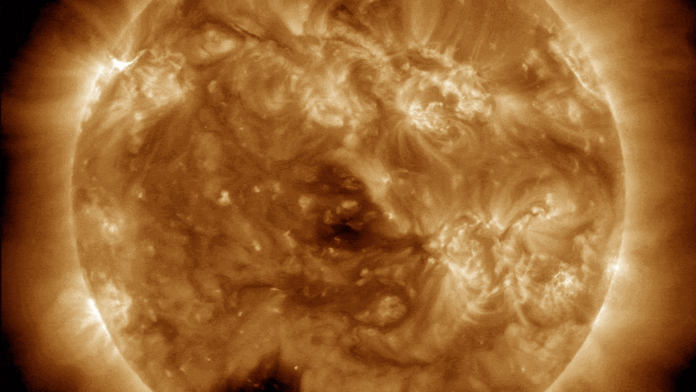A sunspot recently belched out a surprise X-class flare, one of the most powerful solar flares our home star is capable of producing. The enormous explosion created a rarely seen “solar tsunami” across the sun’s surface and unleashed an intense burst of radiation that caused radio blackouts on Earth.
And in a rare recording, a radio astronomer was able to capture the eerie sounds of the solar storm slamming into our planet’s atmosphere.
The X-class flare occurred on Feb. 17, Spaceweather.com (opens in new tab) reported. It was spat out by a sunspot, designated AR3229, which had only recently formed. Solar storm forecasters from the National Oceanic and Atmospheric Administration (NOAA) had predicted a minor chance of an X-class solar flare on that day but believed the threat would come from the much larger sunspot AR3226 instead.
Related: The sun’s wrath: Worst solar storms in history
As a result, astronomers were caught off guard by the stellar blast, which had a magnitude of 2.2, according to Spaceweather.com. (Solar flare classes include A, B, C, M and X, with each class being at least 10 times more powerful than the previous one. Each class is split into separate categories numbered 1 to 9 — except for X-class flares, which have no defined upper limit.)
The flare triggered a rare type of shockwave known as a solar tsunami that rippled across the sun’s visible surface, or photosphere, according to Spaceweather.com. A solar tsunami, also known by scientists as a fast-mode magnetohydrodynamical wave, is basically “a giant wave of hot plasma” that can travel up to 560,000 mph (901,000 km/h) across the photosphere and reach heights of around 62,150 miles (100,000 km), according to NASA (opens in new tab).
Related: 10 solar storms that blew us away in 2022 (opens in new tab)

The flare also emitted a Type II solar radio burst — a stream of mainly ultraviolet and X-ray radiation — that hit Earth shortly after the flare erupted. The radiation ionized the upper atmosphere, causing minor radio blackouts across parts of the Americas for around an hour, according to Spaceweather.com. (There are five categories for solar radio bursts. Type I is the weakest and Type V is the strongest, capable of causing widespread and long-lasting blackouts.)
Amateur radio astronomer and citizen scientist Thomas Ashcraft (opens in new tab), who is based in New Mexico, managed to capture a rare audio recording (opens in new tab) of the radio burst slamming into Earth. The eerie sound is made up of static created by the radiation hitting the atmosphere and was recorded somewhat serendipitously.
The eerie sound clip of the radio burst hitting Earth. (Credit: Thomas Ashcraft)
“The sun was right in my radio telescope beam when the flare occurred,” Ashcraft told Spaceweather.com (opens in new tab). This enabled him to capture the “full force” of the radio burst, which would not have been possible if his telescope was not already pointing at the sun, he added.
X-class flares appear to be occurring more frequently. On Jan. 3, a potential X-class flare, the first of the year, erupted from a massive sunspot hidden on the sun’s far side (opens in new tab). Since then, the sun has spat out another five confirmed X-class flares, including the most recent one. In comparison, there were only seven X-class flares in the entirety of 2022, according to SpaceWeatherLive.com (opens in new tab).
The uptick in X-class flares is likely the result of the sun entering a more lively phase of its 11-year solar cycle, which should peak in 2025. The increase in activity has also caused more sunspots to appear (opens in new tab) on the sun’s photosphere.
This story was originally published on Livescience.com (opens in new tab).

